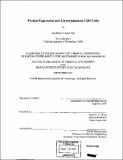| dc.contributor.advisor | Daniel I.C. Wang. | en_US |
| dc.contributor.author | Yuk, Inn Huam Yvonne. | en_US |
| dc.contributor.other | Massachusetts Institute of Technology. Dept. of Chemical Engineering. | en_US |
| dc.date.accessioned | 2005-08-23T18:15:15Z | |
| dc.date.available | 2005-08-23T18:15:15Z | |
| dc.date.copyright | 2001 | en_US |
| dc.date.issued | 2001 | en_US |
| dc.identifier.uri | http://hdl.handle.net/1721.1/8201 | |
| dc.description | Thesis (Ph. D.)--Massachusetts Institute of Technology, Dept. of Chemical Engineering, 2001. | en_US |
| dc.description | Includes bibliographical references (p. 193-207). | en_US |
| dc.description.abstract | A successful mammalian cell culture process depends on sufficient expression and correct glycosylation of the recombinant product. Low product titer and inconsistent protein glycosylation constitute two major problems frequently encountered in biopharmaceutical production. Using Chinese Hamster Ovary (CHO) cells expressing recombinant human interferon-gamma (IFN-y) as the model system, this thesis investigated strategies that can potentially enhance heterologous protein expression or control the extent of protein glycosylation. There has been considerable interest in developing culture strategies to improve productivity in mammalian cell lines by limiting the cellular growth rate. An initial investigation demonstrated the difficulty in obtaining growth-arrested cells that are robust and productive. In the following study, a method to rapidly generate and isolate CHO cells that exhibit enhanced potential for use in proliferation-controlled bioprocesses was developed. By combining bicistronic retroviral technology with an appropriate selection strategy, a subpopulation was isolated from a heterogeneous cell population. To evaluate the effectiveness of this screening process, the performance of this selected subpopulation was compared with that of the original population under identical growth-arresting conditions. Important differences were observed: by contrast to the original population, the selected cells maintained consistently high viabilities and continued to stably express recombinant proteins after being growth-arrested for two weeks. Asparagine-linked (N-linked) glycosylation can significantly impact critical properties of human therapeutic proteins. | en_US |
| dc.description.abstract | (cont.) An essential step in N-linked glycosylation is the transfer of an oligosaccharide from dolichol phosphate (Dol-P) to a potential glycosylation site on a polypeptide. Variability in the success of this reaction affects the extent of glycosylation on proteins. Radiolabeling studies showed that over the course of CHO batch culture, glycosylation precursor concentrations remained within a two-fold range, and overall protein glycosylation increased by 15-25%. Given the key role of Dol-P in glycosylation, its availability was postulated to limit glycosylation by controlling the abundance of glycosylation precursors. To test this hypothesis, the impact of Dol-P feeding on CHO cells was investigated. Although exogenous Dol-P was incorporated by CHO cells and processed into glycosylation precursors in a dose-dependent manner, Dol-P supplementation had no marked effects on the level of glycosylation precursors or on the extent of glycosylation. | en_US |
| dc.description.statementofresponsibility | by Inn Huam Yvonne Yuk. | en_US |
| dc.format.extent | 207 p. | en_US |
| dc.format.extent | 13507036 bytes | |
| dc.format.extent | 13506794 bytes | |
| dc.format.mimetype | application/pdf | |
| dc.format.mimetype | application/pdf | |
| dc.language.iso | eng | en_US |
| dc.publisher | Massachusetts Institute of Technology | en_US |
| dc.rights | M.I.T. theses are protected by copyright. They may be viewed from this source for any purpose, but reproduction or distribution in any format is prohibited without written permission. See provided URL for inquiries about permission. | en_US |
| dc.rights.uri | http://dspace.mit.edu/handle/1721.1/7582 | |
| dc.subject | Chemical Engineering. | en_US |
| dc.title | Protein expression and glycosylation in CHO cells | en_US |
| dc.title.alternative | Protein expression and glycosylation in Chinese hamster ovaries cells | en_US |
| dc.type | Thesis | en_US |
| dc.description.degree | Ph.D. | en_US |
| dc.contributor.department | Massachusetts Institute of Technology. Department of Chemical Engineering | |
| dc.identifier.oclc | 50104610 | en_US |
